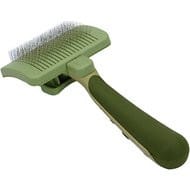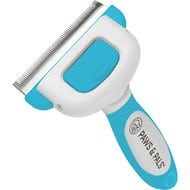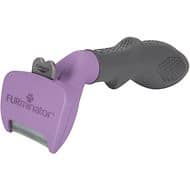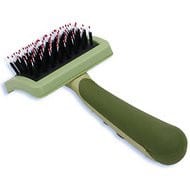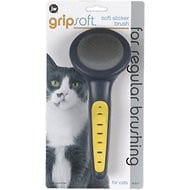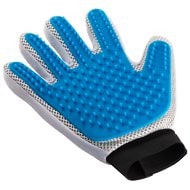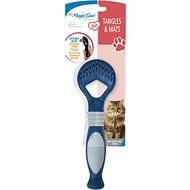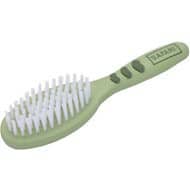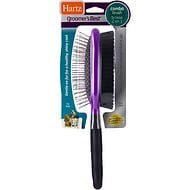Contents
- What Is The Best Cat Brush?
- Choosing the Right Brush for Your Cat
- Tips for Brushing Your Cat Properly
- The Top 9 Cat Brushes
- Safari Self-Cleaning Slicker Brush for Cats
- Paws & Pals Best-in-Show Deshedding Tool
- FURminator deShedding Edge Cat Brush
- Safari Complete Cat Brush
- JW Pet Gripsoft Cat Slicker Brush
- Pat Your Pet Five Finger Grooming Glove
- Four Paws Magic Coat Mat Remover for Cats
- Safari Bristle Cat Brush
- Hartz Groomer’s Best Combo Brush
- Frequently Asked Questions
For all the time your cat spends grooming, you would think he wants to look his best. To make sure your cat is always the cutest one in the room, do your part and help him out with regular brushing. Though your cat does a good job cleaning himself up, brushing is essential to keep his skin healthy and his coat looking its best. Having the right cat brush for the job is essential.
In this article, we’ll talk about the different kinds of cat coats and how to choose a brush that’s appropriate for your cat. We’ll also talk about the different characteristics of a good cat brush and how to use it properly. Finally, you’ll see our top picks for the best cat brush.
What Is The Best Cat Brush?
- Safari Self-Cleaning Slicker Brush
- Paws & Pals Best-in-Show Deshedding Tool
- FURminator deShedding Edge Cat Brush
- Safari Complete Cat Brush
- JW Pet Gripsoft Cat Slicker Brush
- Pat Your Pet Five Finger Grooming Glove
- Four Paws Magic Coat Mat Remover
- Safari Bristle Cat Brush
- Hartz Groomer’s Best Combo Brush
Choosing the Right Brush for Your Cat
Grooming doesn’t have to be an unpleasant experience for both you and your cat. With the right cat brush, it can actually be a simple task for you and an enjoyable experience for your cat. The key is to choose the right brush for your cat’s coat type.
Cats with short hair do best with a slicker brush. These brushes have short, very fine wire bristles that reach into the undercoat but they aren’t long or sharp enough to scratch your cat’s skin. If your cat has a medium-length coat, a dual-sided brush could be a good option because it has wire pins on one side and soft bristles on the other. The best cat brush for long haired cats is usually a brush with longer pins but you may need a separate wide-toothed comb to use for detangling.
There are many different cat brushes to choose from and while some coat types might do best with a certain type of brush, it’s largely a matter of your comfort and your cat’s preference. When shopping for a cat brush, there are a number of factors to consider.
Here are some factors to consider in a cat brush:
- Brush Type – From slicker brushes to mat breakers, there are many types of cat brush. If you want something for daily grooming, look for a simple slicker brush, pin brush, or a soft bristle brush for cats.
- Handle – If you plan to spend a decent amount of time grooming your cat, it should at least be comfortable. Look for a brush with a comfort grip handle that’s easy to hold.
- Bristle Length – The shorter your cat’s fur, the shorter the bristles should be, so they don’t scratch your cat’s skin. Cats with thicker fur may need longer bristles but don’t go too long on a cat with very fine fur or delicate skin.
- Bristle Spacing – Cats with longer fur need more widely spaced bristles than a short haired cat. Consider the coarseness of the bristles too – thicker coats may require coarser bristles.
- Easy Cleaning – The whole purpose of a cat brush is to remove fur from your cat’s coat, but then what? Some cat brushes come with a self-cleaning feature that makes it easy to remove accumulated hair.
Now that you have a better idea what to look for in a cat brush and how to choose the right one for your cat’s coat, you’re probably wondering how to use it properly. Read on to learn some simple tips for brushing your cat the right way.
Tips for Brushing Your Cat Properly
Cats are known for being finicky. They’ll be perfectly happy with you petting them one moment and then biting your fingers the next. You need to be gentle when it comes to grooming your cat, but persistence is needed as well. It also doesn’t hurt to understand the proper way to brush a cat before you try it for yourself – you’ll end up with fewer scratches that way.
Here are some simple tips to follow when brushing your cat:
- Choose a time when your cat is relaxed and start by gently stroking him so he gets used to the rhythm.
- Start at the base of your cat’s neck and work down his back and along his sides, brushing in the direction of hair growth.
- If you’re looking to remove as much hair as possible (and your cat will tolerate it), you can first brush against the direction of growth and then brush with the growth after.
- Clean excess hair from the brush often to avoid creating tangles.
- Be gentle with your cat – don’t put too much downward pressure on the brush or you could scratch or puncture your cat’s skin.
- When you’re finished brushing, wipe your cat’s fur with a soft cloth to remove any remaining loose hair and to give the coat a nice shine.
The Top 9 Cat Brushes
Finding the right cat brush can be tough because cats are picky. By following the tips above, however, you’ll at least have a good place to start. When you’re ready to start looking at your options, check out some of our favorite cat brushes.
Here are our top picks for the best cat brushes:
| Our 2023 Picks: Best Cat Brushes | |||
Safari Self-Cleaning Slicker Brush for Cats
|
CHECK PRICE | ||
Paws & Pals Best in Show Deshedding Tool
|
CHECK PRICE | ||
FURminator deShedding Edge Cat Brush
|
CHECK PRICE | ||
Safari Complete Cat Brush
|
CHECK PRICE | ||
JW Pet Gripsoft Cat Slicker Brush
|
CHECK PRICE | ||
Pat Your Pet Five Finger Grooming Glove
|
CHECK PRICE | ||
Four Paws Magic Coat Mat Remover for Cats
|
CHECK PRICE | ||
Safari Bristle Cat Brush
|
CHECK PRICE | ||
Hartz Groomer’s Best Combo Brush
|
CHECK PRICE | ||
Safari Self-Cleaning Slicker Brush for Cats
The Best Cat Brush Overall:When it comes to the best cat brush, you want something that does a good job of removing hair, but it shouldn’t be too rough on your cat. This Safari Self-Cleaning Slicker Brush for Cats is the perfect solution because it is covered in very fine stainless-steel bristles that reach through the undercoat to remove hair without scratching or irritating your cat’s skin. It also features a soft, comfort grip handle and a self-cleaning feature to easily remove accumulated fur.
Pros: Fine stainless-steel bristles, self-cleaning feature, comfort grip handle
Cons: May not work as well for very long coats
Paws & Pals Best-in-Show Deshedding Tool
The Best Cat Brush for Shedding: All cats shed but you can keep it under control with regular brushing sessions to remove dead and loose hair before it can be shed. This Paws & Pals Best-in-Show Deshedding Tool is a great option because it features a sturdy stainless-steel blade with teeth long enough to reach into the undercoat but not sharp enough to pierce your cat’s skin. This brush has an ergonomic soft-grip handle for comfort and to make sure you’re always in control for your cat’s safety. Used regularly, this brush helps reduce shedding and dander, plus it helps stimulate the production of natural oils in your cat’s skin.
Pros: Helps reduce shedding and dander, sturdy stainless-steel blade, soft-grip ergonomic handle
Cons: Some cats don’t like the feel of it, may tug on mats or tangles
FURminator deShedding Edge Cat Brush
The Best Cat Brush for Short Haired Cats: Deshedding blades work well for short-haired cats and this FURminator deShedding Edge Cat Brush is one of the most popular models out there. It comes in two sizes so you can choose the right option for your cat and it features a rubberized ergonomic grip handle for your own comfort. This brush reduces loose hair from shedding up to 90% with regular use and it is easy to use. The stainless-steel blade reaches easily into your cat’s undercoat to remove hair and the curved edge conforms to your cat’s natural shape for improved comfort and safety.
Pros: Reduces shedding up to 90% with regular use, curved edge for comfort, ergonomic grip handle
Cons: May take time to learn how to use it, may tug on mats and tangles
Safari Complete Cat Brush
The Best Cat Brush for Long Haired Cats: If you’re looking for a cat brush for a long-haired cat, this Safari Complete Cat Brush could be a good option. It’s a combination of a pin brush and a bristle brush but the longer bristles work well for cats with medium to long coats. The pins are round tipped for your cat’s safety and the bristles soft to avoid scratching his skin. Regular use will reduce shedding and distribute the natural oils in your cat’s skin.
Pros: Round tips to protect skin, removes tangles and loose hair, distributes natural oils
Cons: Can be tough to remove accumulated hair
JW Pet Gripsoft Cat Slicker Brush
The Best Cat Brush for Kittens: When your kitten is first getting used to grooming, you don’t want to scare him with a brush that’s too big or heavy. This JW Pet Gripsoft Cat Slicker Brush is a great option because it features a small head with soft, fine bristles. As a slicker brush, it’s designed to reach through the coat to remove loose fur, but the bristles are round tipped so they won’t scratch your kitten.
Pros: Round head perfectly sized for kittens, round tipped bristles for safety, removes loose fur
Cons: Some kittens find it uncomfortable
Pat Your Pet Five Finger Grooming Glove
The Best Cat Brush for Senior Cats: Senior cats can become delicate in their old age, but grooming is still important. If you’re worried about hurting your cat’s sensitive skin or aggravating an injury, these Pat Your Pet Five Finger Grooming Gloves might be the ideal fit. Simply slip them over your hands and pet your cat like your normally would. The rubber bristles gently work through the coat to remove loose hair without hurting your cat at all.
Pros: Soft rubber bristles collect hair, adjustable strap for comfort, easy to use
Cons: May need to remove accumulated hair frequently
Four Paws Magic Coat Mat Remover for Cats
The Best Cat Brush for Mats: Long-haired cats tend to develop tangles which, if left unresolved, can turn into painful mats. This Four Paws Magic Coat Mat Remover for Cats is the perfect solution to help you get rid of tangles and mats efficiently without hurting your cat. This comb features a non-slip grip for your comfort and maximum control, and it is made with a double row of stainless-steel pins that remove mats without cutting your cat’s fur. Simply follow the simple instructions that come with the brush.
Pros: Double row of stainless-steel pins, ergonomic grip handle, designed for tangles and mats
Cons: May take time to learn how to use it, some cats dislike it
Safari Bristle Cat Brush
The Best Bristle Brush for Cats: If you’re looking for a soft bristle brush for cats, we recommend the Safari Bristle Cat Brush. Though it’s simple in design, this brush does what it’s meant to do. It features soft nylon bristles to remove loose and dead hair from your cat’s coat while improving the shine. Because the bristles are soft, they conform to the shape of your cat’s body to keep him calm and comfortable during grooming.
Pros: Soft nylon bristles, contours to the shape of the body, improves coat shine
Cons: Can be tough to remove accumulated hair
Hartz Groomer’s Best Combo Brush
The Best Double-Sided Cat Brush: Whether you have a cat with a medium-length coat or multiple cats in the same house, this Hartz Groomer’s Best Combo Brush could be the perfect solution. This brush features two sides, a bristle brush on one side and a wire pin brush on the other. The pin side features stainless-steel pins with rounded tips for safety while the other side has nylon bristles to bring out softness and shine.
Pros: Wire pin and bristle brush in one, comfort grip handle, designed for comfort and safety
Cons: May be too large for some cats
Frequently Asked Questions
- Why should I brush my cat? Cats do a pretty good job of grooming themselves, but we all need help from time to time. Long-haired cats are prone to mats and tangles, for example, which can sometimes be tough for your cat to work through. Brushing is good for all cats, however, because it helps stimulate the oil glands in the cat’s skin and distributes the natural oils more evenly to moisturize the skin and hydrate the coat.
- How often does my cat need to be brushed? If your cat enjoys being brushed, there’s no reason not to make it a daily activity – it’s a great opportunity for bonding with your cat. When it comes to caring for your cat’s coat, however, you really only need to do it as often as his coat dictates. Short-haired cats do well with weekly brushing but cats with longer hair may need it more often to manage mats and tangles.
- Should I brush my cat before bathing? Yes, it’s always a good idea to brush your cat before bathing. Not only will it help remove mats and tangles that you might accidentally pull during the bath, but it removes dead and loose fur, so it doesn’t clog up your drain. It may also help loosen dander from your cat’s coat so you can wash it away more easily – this is a bonus for people with cat allergies.
- How do I brush a cat that’s scared of the brush? If your cat is nervous about grooming, you’ll need to take some time to desensitize him. Start by sprinkling a little catnip on the brush and let your cat explore it for himself. Once he learns that the brush isn’t a threat, you can try bushing him a little with it. Make sure your cat is in a comfortable position and hold him but don’t make him feel trapped. Some cats prefer grooming mitts because it feels more like they are being petted than brushed.
- Should I wet my cat’s fur before brushing? Generally speaking, you shouldn’t need to prep your cat’s fur in any way before brushing. If your cat has a lot of mats and tangles, however, you might try a detangling spray. To keep your cat’s coat smelling fresh and clean between baths, waterless shampoo works well, and it may work best if you brush it through your cat’s coat after applying it.
As a cat owner, you love to spoil your cat. In addition to feeding him the best food you can afford, why not pamper him with a daily grooming session? Whether your cat’s coat really needs it or not, regular brushing feels good and it’s good for him. Check out our top picks for the best cat brushes above to choose the one that’s perfect for your pet.


